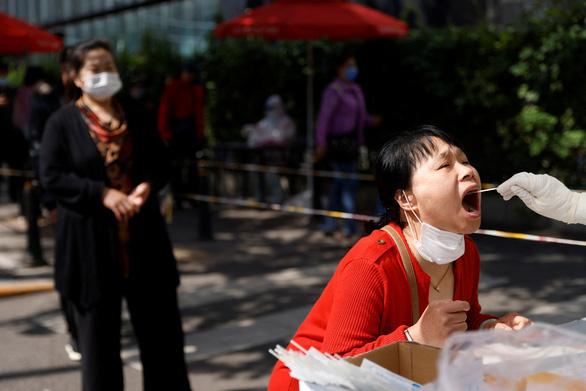Beijing tries to avoid Shanghai ‘scenario’

Medical staff collect PCR test samples in Beijing, China on 3-5 – Photo: REUTERS
From May 3, Beijing began testing all people in 12/16 districts in a row for 3 days.
From repeated testing to a ban on going to public places if there is no negative COVID-19 test result, Beijing is raising its vigilance over the latest outbreak even though it has only recorded about 400 cases so far. infected – a very small number compared to other cities in the world.
How is Beijing?
Since the beginning of the COVID-19 pandemic until now, the capital Beijing has never been completely blocked. To avoid the situation of Shanghai – a city of about 26 million people that has been locked down for more than a month, Beijing is taking tough measures sooner.
Residents in major counties here have all undergone mass testing to eliminate unknown chains of infection and detect asymptomatic cases early. Beijing has also carried out large-scale PCR tests since April 25.
During the 5-day May 1 holiday (April 30 to May 4), the Beijing government requires all residents to present a negative PCR test result within 48 hours if they want to travel to the city. places such as scenic spots, hotels…
The increase in anti-epidemic measures has made the bustling destinations during the holidays become deserted. Last weekend, many people were prevented from entering parks in central Beijing because there were no negative PCR results.
Meanwhile, all restaurants in the city have suspended dine-in service, only for takeout, effective from 1 to 4 May.
As noted by Bloomberg News, a coffee shop in Beijing set up chairs outside so customers could enjoy a drink under a tree, but then the police dispersed.
According to the Global Times, from May 5, the first working day after the May 1 holiday, Beijing Capital International Airport will require all passengers to present a negative PCR test result. present within 7 days.
Beijing will no blockade?
Due to the increasing number of infections, two more residential areas in Chaoyang District and one in Fangshan District were added to the list of high-risk areas earlier this week. As of May 2, Beijing had at least 10 high-risk areas and 26 medium-risk areas.
To date, Beijing has recorded a total of about 400 infections in the latest outbreak, of which Chaoyang has the most infections (156 cases). On May 3, Beijing recorded 51 new symptomatic cases and 11 asymptomatic cases in 6 counties.
The Beijing Center for Disease Control and Prevention (CDC) has completed genetic sequencing of hundreds of patient samples during the latest outbreak. The results show that these cases are related to the Omicron variant.
“After analyzing the recorded cases, Beijing CDC found that many outbreaks were caused by people gathering to eat at restaurants and many people had not been vaccinated against COVID-19, which increased risk of infection,” said Ms. Pang Xinghua, deputy director of the Beijing CDC.
At a press conference on May 3, Beijing Health Commission officials said that after the latest three rounds of PCR tests, they will evaluate the overall situation to decide on the strategy and how to organize PCR testing. next.
In the immediate future, there are no clear signs that Beijing will blockade like Shanghai.
“I believe Beijing will never blockade the whole city until it is absolutely necessary. Beijing will fight this epidemic in a relatively normal way” – Mr. Hu Xijin, former editor-in-chief of the Times Hoan Cau, comment.
Rescue by “white list”
According to CNBC, many businesses in China’s two largest cities, Shanghai and Beijing, are facing restrictive measures imposed on their businesses.
From Beijing Universal Resort (closed on May 1) to Tesla, factories … are affected.
To help key companies resume production and minimize the impact of COVID-19 on the supply chain, China has introduced a “white list” approach.
Last week, Shanghai put on a second “white list” of 1,188 companies that could resume production under a closed process, bringing the number of companies on this list to 1,854.
The EU Chamber of Commerce in China called the white list a “promising sign for Shanghai’s recovery”.
at Blogtuan.info – Source: tuoitre.vn – Read the original article here




